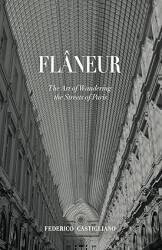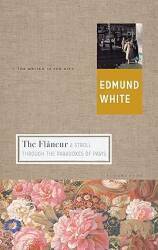
The Art of Flânerie
Wandering Pigalle and Montmartre
Flânerie in the 10ème arrondissement
The flâneur
is someone who strolls aimlessly as an observer of society.
The idea of the activity
flânerie as
strolling or idling dates to the 16th or 17th century,
often referring to wasting time.
But writers in the 19th century, especially Charles Baudelaire,
developed a rich set of honorable interpretations of the
flâneur and flânerie.
Building on my
first page
explaining the way of the flâneur,
here is further aimless wandering in Paris.
I was staying at the Vintage hostel at 73 rue de Dunkerque, a short walk from Gare du Nord. A short walk on up Rue de Dunkerque, a petite flânerie as it were, takes me to the Anvers Métro station at the base of Montmartre, the hill topped by Basilique Sacré-Cœur.

Montmartre is the highest point in Paris. The basilica is a political and cultural monument, built from 1875 to 1914 as a national penance for the events of 1870-1871, the war and the commune.
The Franco-Prussian war led to the capture of Emperor Napoleon III and the collapse of the Second French Empire. The Third Republic was established but its capital moved to Tours.

The Paris Commune defended the city. It was a radical socialist and revolutionary government relying on the National Guard rather than regular Army troops. Paris surrendered, and the new chief executive of the French national government signed an armistice with Prussia. They disarmed the Army but not the National Guard.
On 18 March 1871, soldiers of the Commune killed two French Army generals, and the Commune announced that it did not accept the authority of the French national government. The Commune governed Paris for two months, until it was defeated by regular French Army forces during le semaine sanglante or "The Bloody Week", beginning 21 May 1871. Montmartre had been the most rebellious neighborhood of the Commune.
Amazon
ASIN: 0143108123
Amazon
ASIN: 0062431897
Through the 9th Arrondissement
On Sunday mornings an informal market sets up in the median running down the center of Boulevard de Rochechouart.



Climbing Montmartre
Turning north and starting up the butte of Montmartre, I pass the corner where the magic of cinema had placed a small café in the movie Ronin.

That corner to the left of the staircase has now been demolished, and a new multi-story building is rising there.

And then further up. This is the highest area in the city.

L'Éspace Dalí
Near the Place du Tertre I come to L'Éspace Dalí, also called Dalí Paris. It's a permanent exhibition space showing the works of Salvador Dalí, especially his sculptures and engravings.




Place du Tertre and Basilique Sacré-Cœur
Place du Tertre is a square near the summit of Montmartre. It was the center of the Benedictine Montmartre Abbey established by King Louis VI in 1133.

A sign explains that La Mere Catherine is where the word "bistro" was born.
French troops had been led east by Napoleon, who thought it was reasonable to march into Russia in the winter. What could possibly go wrong?
This had not gone well for the Napoleonic army. But they had managed to pick up one word of Russian, быстро or bistro, meaning "fast" or "quickly".
They famously gathered here at La Mere Catherine and banged their cups on the tables while chanting быстро. The concept of the French bistro was born.

at Pamukkale
The Basilique Sacré-Cœur is nearby. It's built from travertine limestone, which forms by the rapid precipitation of calcium carbonate at mineral springs. The travertine used to build the basilica came from Château-Landon, close to Paris in the Île-de-France.

There's a great view out over the eastern half of Paris.

Let's come back on a sunny day and see the white travertine in the sunlight.


Nice! But now back to the original sequence. The flâneur will take advantage of weather, but will not be a slave to it.
I have descended through the staircase-only passages and streets, and now I am down where wheeled vehicles can freely operate.

Pigalle
I have descended the rest of the way down Montmartre to Pigalle.

Pigalle is the "ooh la la" tourist district, with lots of sex shops with English signs. US troops called the area "Pig Alley" in 1945.


One of the Sex Shops distinguishes itself with Sexy Santa.




The Blanche Métro station is on the square facing the Moulin Rouge nightclub.

I got lunch nearby at un restaurant indo-chinois français.


Pho et vin rouge.
Many people maintain that pho or phờ in Vietnamese derives from the French pot-au-feu or "pot on the fire".
Then, of course, back to wandering.

Some structures in Pigalle date from la Belle Époque.

in France
Fanatics who watch Fox "News" all day long insist that people who live outside the two or three largest cities in France have no electricity.
But here's a small shop stuffed with electrical gear.


Boulevard de Rochechouart
Back down the hill at Boulevard de Rochechouart I joined the locals relaxing at Le Diplomate.

There's a nice view across Boulevard de Rochechouart up Montmartre.

And then later, dinner in the neighborhood near the hostel, poulet rôti.








